First Theatrical Release: November 18, 1988
First Home Viewing Release: September 25, 1996
My Rating: 4/5 stars
Where I Found It: My family’s VHS collection (we had the first release)
Bechdel Test Score: Failed. Female characters include Rita, Jenny, and Georgette. None of them ever speak to one another.
Although Oliver & Company was not a critical success, I think of it as the prologue to my Disney obsession that kicked off in earnest with the release of The Little Mermaid. Oliver holds a special place in my heart as the first Disney movie I saw in theaters during its initial release — all the others I had seen in re-releases. It was the first Disney movie that I heard my parents talk about with admiration, in regards to how “real” the rain looked in the early sequences. And although accidental, it started a tradition of seeing Disney releases in the theater more than once that would endure all the way through Hercules. (In this case, it happened because my best friend asked me to go to the movie after I had already seen it with my family; rather than turn her down, I went to it again.)
The eight-year wait between its theatrical release and the video release was a long one for me, during which I obsessively watched “Why Should I Worry?” and “You and Me,” on Disney Singalong tapes while I dreamed of viewing the whole movie again.
I still found a lot to like here.
But first, let’s get the cringe-inducing stuff out of the way.
Dodger and Tito Are Totally Street Harassers
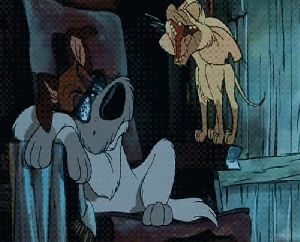 I was as taken in as anyone else by how “cool” Dodger was when I was younger, and how “hilarious” Tito was. But as an adult, I felt a little disgusted at the way Dodger cat calls and makes kissy faces at a prissy dog in his opening sequence, despite the fact that she is clearly not interested. These same antics emerge when the dog gang is out together later, around the time they hotwire the Foxworths’ car. And of course, there is Tito’s insistence that Georgette is his “woman” even after she has told him in no uncertain terms that she is not interested. Which brings us to the larger problem of Tito.
I was as taken in as anyone else by how “cool” Dodger was when I was younger, and how “hilarious” Tito was. But as an adult, I felt a little disgusted at the way Dodger cat calls and makes kissy faces at a prissy dog in his opening sequence, despite the fact that she is clearly not interested. These same antics emerge when the dog gang is out together later, around the time they hotwire the Foxworths’ car. And of course, there is Tito’s insistence that Georgette is his “woman” even after she has told him in no uncertain terms that she is not interested. Which brings us to the larger problem of Tito.
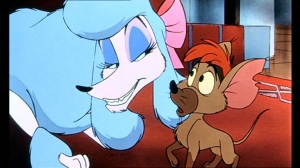 When I was a child, I found amusement in Tito’s “funny accent,” never realizing that it was a Latino accent, and that its exaggeration, along with its assignment to a “Mexican” dog breed, combined to make the movie’s sole minority character the butt of most of the jokes. He is the dog we most often see engaged in downright “criminal” acts, like hot-wiring cars and vandalizing electronic equipment, whereas most of the other dogs are involved in “diversion” tactics (with th exception of Dodger who is shown explicitly stealing). He’s also the only character to express romantic interest in Georgette, one of the only female dogs in the movie, playing into the stereotype that Latino men are more “passionate” or “oversexed.”
When I was a child, I found amusement in Tito’s “funny accent,” never realizing that it was a Latino accent, and that its exaggeration, along with its assignment to a “Mexican” dog breed, combined to make the movie’s sole minority character the butt of most of the jokes. He is the dog we most often see engaged in downright “criminal” acts, like hot-wiring cars and vandalizing electronic equipment, whereas most of the other dogs are involved in “diversion” tactics (with th exception of Dodger who is shown explicitly stealing). He’s also the only character to express romantic interest in Georgette, one of the only female dogs in the movie, playing into the stereotype that Latino men are more “passionate” or “oversexed.”
Oh, and by the way, the fact that I couldn’t place Tito’s accent when I was a child wasn’t because I had not been exposed to Latino accents. We had a friend from Mexico who came to stay with our family every summer for most of my childhood. I had heard a real Latino accent — and while I noticed that it was different, it never struck me as funny. The fact that my child’s brain saw no connection between Tito and the real Latino man I knew emphasizes how much Disney exaggerated Tito’s characteristics for comic effect.
I could still remember which of Tito’s one-liners I laughed the hardest at when I was a child. I wasn’t laughing this time around.
Yet, Disney’s Portrayal of Hobos is Surprisingly Generous
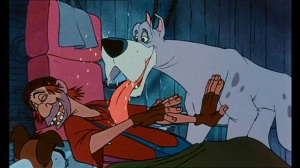 Despite its regressive portrayal of minorities, Disney’s portrayal of Fagin, a homeless man whose only friends are his pack of mutts, is surprisingly warm. Fagin certainly looks like a homeless person, with his worn-out sneakers, oversized trenchcoat, and unshaven face. He depends upon his dogs for his survival and, seemingly, his emotional support. He reminded me of the homeless people I saw in Europe, many of whom had dogs with them. One might wonder how a homeless person can take responsibility for a dog when he doesn’t even know where his next meal is coming from, but anyone who’s owned a dog knows they are worth their weight in gold when it comes to unconditional love. And that is probably something the homeless need just as much as food.
Despite its regressive portrayal of minorities, Disney’s portrayal of Fagin, a homeless man whose only friends are his pack of mutts, is surprisingly warm. Fagin certainly looks like a homeless person, with his worn-out sneakers, oversized trenchcoat, and unshaven face. He depends upon his dogs for his survival and, seemingly, his emotional support. He reminded me of the homeless people I saw in Europe, many of whom had dogs with them. One might wonder how a homeless person can take responsibility for a dog when he doesn’t even know where his next meal is coming from, but anyone who’s owned a dog knows they are worth their weight in gold when it comes to unconditional love. And that is probably something the homeless need just as much as food.
Most of us could learn a LOT from Disney’s non-judgmental portrayal of Fagin. Yes, he’s dirty, and yes he steals to get by. But we sympathize with his plight when he cannot pay Fagin back; we see Sykes as the bad guy even if Fagin does owe a legitimate debt; we do not blame Fagin for attempting to extort a ransom for Oliver, and our heart melts when he meets Jenny and can’t go through with it. It’s clear from the way he readily accepts Oliver into the gang and the way he reads his dogs bedtime stories at night that, while he may be short on cash, he still has a heart of gold.
 I also love that he attends Jenny’s birthday party at the end and enjoys watching a wrestling match with Winston in the kitchen. In real life, most custodians of a wealthy child would be the last ones to invite a homeless man and his mangy dogs into their home. I like that this movie takes place in a more perfect world where such class divisions truly can be transcended. (I did wonder whether the same would have happened if Jenny’s parents were home, however.)
I also love that he attends Jenny’s birthday party at the end and enjoys watching a wrestling match with Winston in the kitchen. In real life, most custodians of a wealthy child would be the last ones to invite a homeless man and his mangy dogs into their home. I like that this movie takes place in a more perfect world where such class divisions truly can be transcended. (I did wonder whether the same would have happened if Jenny’s parents were home, however.)
The Relationship Between a Girl and her Cat is a Beautiful Thing
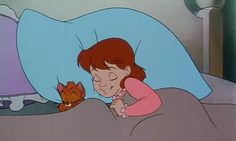 Although I make exceptions for special dogs all the time — including my own dog that I adore — at heart I am a “cat person.” I was about the same age as Jenny when I first saw this movie, and her relationship with Oliver served as a kind of wish fulfillment for me. (My parents let me have cats, but they couldn’t be in the house.) As an adult who now lives with cats, I still found the portrayal of Jenny’s bond with Oliver to be touching, adorable and emotionally resonant even if some of the details may have been off. (I don’t know many cats that would sit patiently in a boat.) It even corrected the mistake in the Aristocats in which a single woman who loves cats denies herself the joy of letting them sleep in her bed.
Although I make exceptions for special dogs all the time — including my own dog that I adore — at heart I am a “cat person.” I was about the same age as Jenny when I first saw this movie, and her relationship with Oliver served as a kind of wish fulfillment for me. (My parents let me have cats, but they couldn’t be in the house.) As an adult who now lives with cats, I still found the portrayal of Jenny’s bond with Oliver to be touching, adorable and emotionally resonant even if some of the details may have been off. (I don’t know many cats that would sit patiently in a boat.) It even corrected the mistake in the Aristocats in which a single woman who loves cats denies herself the joy of letting them sleep in her bed.
Unlike most of Disney’s animal movies where we perceive everything from the animals’ point of view, this movie gives the human caregivers equal screentime, and pays special homage to the bonds between pets and their humans. My heart still just melts every time I hear Jenny’s “You and Me.”
Watch Out for Those Plot Holes
Anytime you try to condense a Charles Dickens novel in to an animated musical comedy for children, there are going to be some major gaps. Especially when the team doing the adaptation is known for keeping character names and nothing else from its source material.
 I really wanted to know why Sykes had lent money to Fagin, and also what industry Sykes was in. It seemed to be shady, but all we know about him is that he dresses in a business suit, drives a fancy car, has two purebred Dobermans, and seems to work in a warehouse with lots of security cameras. Does anyone have insight into the nature of his work?
I really wanted to know why Sykes had lent money to Fagin, and also what industry Sykes was in. It seemed to be shady, but all we know about him is that he dresses in a business suit, drives a fancy car, has two purebred Dobermans, and seems to work in a warehouse with lots of security cameras. Does anyone have insight into the nature of his work?
Also, there’s the elaborate scene in which the gang of animals works together to stop Winston’s car as he drives Jenny somewhere. This is crucial to the plot because it is in this encounter that Jenny meets Oliver. But after Tito fries the car’s wires and skedaddles, it’ snot clear what the whole ruse was really about. The dogs didn’t seem to steal anything from Winston or the other stopped cars, AND Winston’s car seems to have gotten home fine even after Tito’s ministrations. O-kay …
 This was the first time I noticed that Oliver does not refer to himself by that name, nor do any of the dogs. Only Jenny ever calls him Oliver — apparently she named him after adopting him, which is normal, but it’s strange that he didn’t have a name while he was with Fagin’s gang. All the dogs had names. Why didn’t anyone name Oliver, or ask him what his name was?
This was the first time I noticed that Oliver does not refer to himself by that name, nor do any of the dogs. Only Jenny ever calls him Oliver — apparently she named him after adopting him, which is normal, but it’s strange that he didn’t have a name while he was with Fagin’s gang. All the dogs had names. Why didn’t anyone name Oliver, or ask him what his name was?
And this might not be a plot hole as much as horrible incompetence: WHERE THE HECK WAS WINSTON WHEN JENNY WAS WANDERING AROUND A BAD NEIGHBORHOOD ALONE LOOKING FOR HER RANSOMED CAT?!? He seems like a nice enough guy, but the fact that his charge was kidnapped on his watch might urge the Foxworths to reconsider who they leave Jenny with the next time the go out of town.
Really, a movie with this many plot holes ought not receive 4 out of 5 stars, but that’s where nostalgia colors my rating. Despite everything, this movie just makes me feel good.
Up next … the Disney Renaissance! I am giddy with excitement.


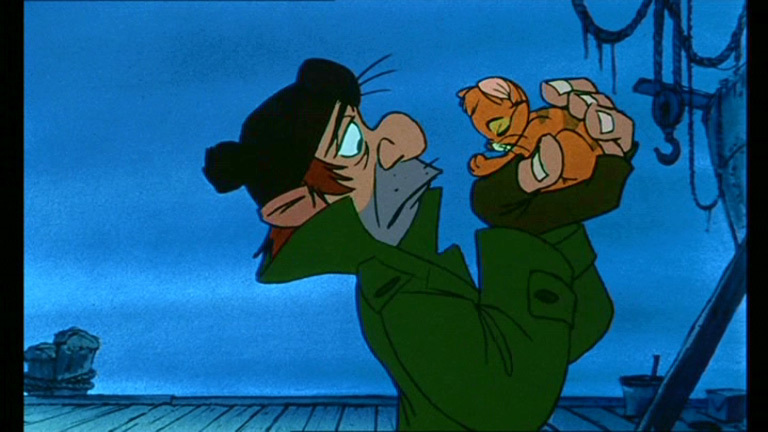

About Sykes’s “job”… I never questioned for a second that he was a high-ranking gangster, and probably a member/associate of the New York mafia.
LikeLike